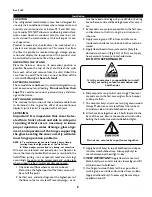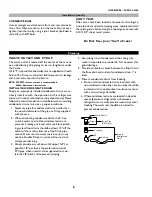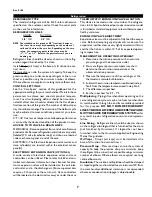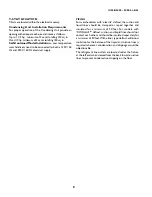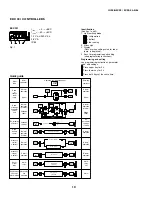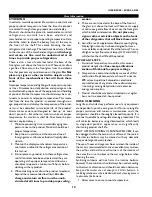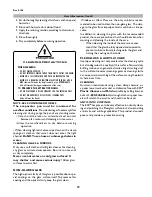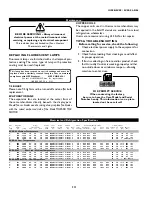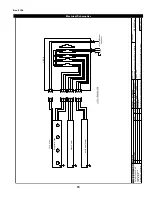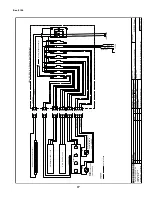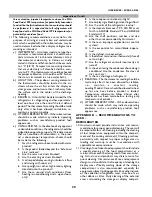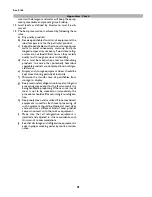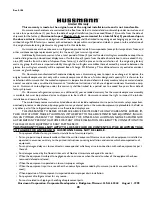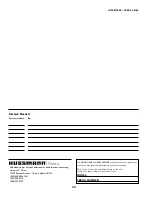
Rev. 0108
19
APPENDIX A. – TEMPERATURE
GUIDELINES
REFRIGERATED
The refrigerators should be operated according to
Hussmann’s published engineering specifications for en-
tering air temperatures for specific equipment applica-
tions. Table 1 shows the typical temperature of the air
entering the food zone one hour before the start of
defrost and one hour after defrost for various categories
of refrigerators. Refer to Appendix C for Field Evaluation
Guidelines.
TABLE 1
TYPE OF
TYPICAL ENTERING
REFRIGERATOR
AIR TEMPERATURE
I. OPEN DISPLAY
A. Non frozen:
1) Meat
28
°
F
2) Dairy/Deli
32
°
F
3) Produce
a. Processed
36
°
F
b. Unprocessed
45
°
F
B. Frozen
0
°
F
C. Ice Cream
-5
°
F
II. CLOSED DISPLAY
A. Non frozen:
1) Meat
34
°
F
2) Dairy/Deli
34
°
F
3) Produce
a. Processed
36
°
F
b. Unprocessed
45
°
F
B. Frozen
0
°
F
C. Ice Cream
-5
°
F
Single Deck
Multi Deck
Service Case
Reach-In
I. Open Display Styles
II. Closed Display Styles
APPENDIX B. – APPLICATION
RECOMMENDATIONS
REFRIGERATED
1.0 Temperature performance is critical for controlling
bacteria growth. Therefore, the following recommen-
dations are included in the standard. They are based
on confirmed field experience over many years.
1.1 The installer is responsible for following the installa-
tion instructions and recommendations provided by
Hussmann for the installation of each individual type
refrigerator.
1.2 Refrigeration piping should be sized according to the
equipment manufacturer’s recommendations and in-
stalled in accordance with normal refrigeration prac-
tices. Refrigeration piping should be insulated accord-
ing to Hussmann’s recommendations.
1.3 A clogged waste outlet blocks refrigeration. The
installer is responsible for the proper installation of
the system which dispenses condensate waste through
an air gap into the building indirect waste system.
1.4 The installer should perform a complete start-up
evaluation prior to the loading of food into the
refrigerator, which includes such items as:
a)
Initial temperature performance, Coils should be
properly fed with a refrigerant according to
manufacturer’s recommendations.
b)
Observation of outside influences such as drafts,
radiant heating from the ceiling and from lamps.
Such influence should be properly corrected or
compensated for.
c)
At the same time, checks should be made of the
store dry-bulb and wet-bulb temperatures to
ascertain that they are within the limits pre-
scribed by Hussmann.
d)
Complete start-up procedures should include
checking through a defrost to make certain of its
adequate frequency and length without substan-
tially exceeding the actual needs. This should
include checking the electrical or refrigerant
circuits to make sure that defrosts are correctly
programmed for all the refrigerators connected
to each refrigeration system.
e)
Recording instruments should be used to check
performance.
APPENDIX C. – FIELD
RECOMMENDATIONS -
REFRIGERATED
Recommendations for field evaluating the performance
of retail food refrigerators and hot cases
1.0 The most consistent indicator of display refrigerator
performance is temperature of the air entering the
product zone (Refrigerated see Diagram 1, Appendix
A). In practical use, the precise determination of
return air temperature is extremely difficult. Read-
ings of return air temperatures will be variable and
results will be inconsistent. The product temperature
alone is not an indicator of refrigerator performance.
NOTE: Public Health will use the temperature of the
product in determining if the refrigerator will be allowed
to display potentially hazardous food. For the purpose of
Appendices
Содержание SCSS
Страница 22: ...IGSSB SCSS SCSS SL 0108 22 ...

